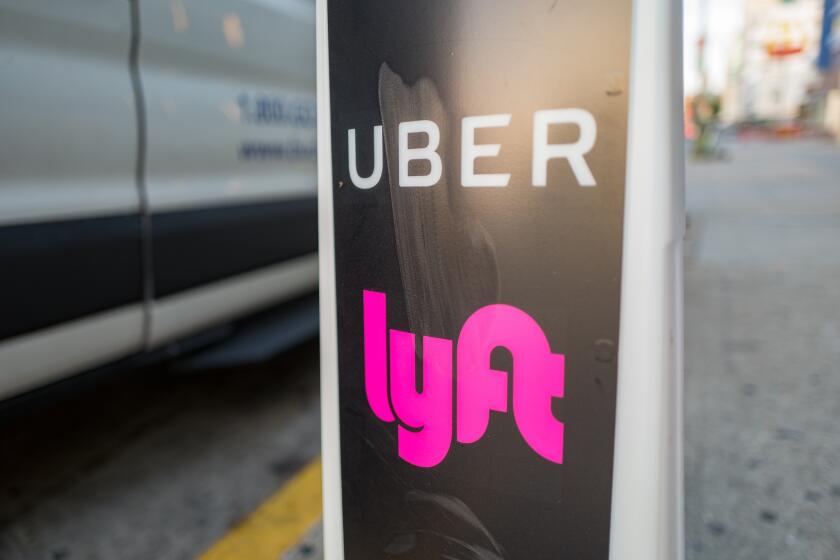A ride on an autonomous bus: No driver, no steering wheel, no brake pedal, no kidding
- Share via
The tinted glass doors on the cozy electric shuttle slid open quietly.
“Welcome aboard,” said Aaron Foster, a solutions engineer for Navya, the French maker of the 15-passenger, battery-powered vehicle that attracted a curious crowd eager for a quarter-mile ride on the ballyhooed bus expected to be running this spring in southeast Orlando, Fla.
The emission-less vehicle had no driver, no steering wheel, no gas pedal, no brake pedal.
No kidding.
“If there’s ever a situation that’s unsafe, the vehicle will actually come to a stop on its own,” Foster said Thursday, describing himself as the autonomous vehicle’s attendant, who is required by federal law to be in control of the bus.
“Just in case,” he said, standing finger-ready at the helm of a side-mounted tablet.
Then, as if on cue — and it wasn’t — the Beep jerked to a sudden stop to avoid bumping into a TV reporter who stood in its programmed path to demonstrate how the multi-sensor technology allows the vehicle to interact with its environment.
Alerted by sensors, its horn also honked until the reporter got out of the way.
The vehicle, marked with decals that read “go-beep.com” and “MOVE NONA,” is one of two that are slated to become the first-ever autonomous public transit vehicles in Central Florida, moving passengers in Orlando’s Lake Nona neighborhood, a mixed-use planned community developed by investment firm Tavistock Group.
The service is expected to be free.
Other Navya autonomous shuttles already operate in downtown Las Vegas and at the University of Michigan in Ann Arbor, as well as internationally on public roads and private sites in Britain, Australia, Japan and Hong Kong.
“I would 100% use it,” said Omar Hickman, founder of digital media company Lake Nona Social, unconcerned his five-minute ride had been driverless. “I’m very comfortable in the technology. I think sometimes it’s safer than actual humans.”
He said the vehicle could help sell tech clients on what the future in Lake Nona holds.
“It was amazing. Nice and smooth,” real estate broker Ernie Plaza said of his ride.
He noted the vehicle made a complete stop at a stop sign — something vehicles with drivers often don’t do.
The short demo ride also impressed Scott Workman, owner of the Villages Transportation, which operates in a retirement community about 60 miles northwest of Orlando.
“I’m in the bus business,” he said of a shuttle service he operates in the community with a population of 125,000. “They’ve thought of every safety feature that I can think of on the vehicle.”
He praised the panoramic view from inside the bus, a nice feature for riders.
Workman said he could envision similar vehicles operating fixed routes in the Villages community, with an important tweak.
“With Florida, the air-conditioning unit probably has to be beefed up,” Workman pointed out. “The bay doors are very large so when they open, they release the cool air and the warm air comes in. You know how Florida is.”
Sanaa Raza described her ride as “smooth and very soothing, relaxing, very easy.”
“It would be cool if it went a little faster,” she said.
The top speed is 16 mph — one mile per hour faster than the electric pedal-assist Lime bicycles available in Orlando.
Mark Reid, an executive at Lake Nona-based Beep, Navya’s partner, said he hopes to ride the driverless shuttle from home to work when the vehicle progresses from a fixed-route schedule to an on-demand service such as Uber or Lyft.
As for the plodding pace of the vehicle, Reid said it was made to travel up to 28 mph. He said as the vehicle proves safe and the controlling technology proves reliable, he expects laws to change allowing it to go a little faster.
During demos, the vehicle repeated an undulating route, varying no more than a few centimeters.
Foster, the on-board monitor, boasted about its safety record.
“We’ve moved well over 300,000 passengers safely in over 20 different countries,” he said. “The only incident we ever had was when our shuttle came to a complete stop because it sensed an oncoming vehicle and it backed into us.”
The fender bender took place in November 2017, the day the company debuted its driverless shuttle in Las Vegas.
More to Read
Inside the business of entertainment
The Wide Shot brings you news, analysis and insights on everything from streaming wars to production — and what it all means for the future.
You may occasionally receive promotional content from the Los Angeles Times.











